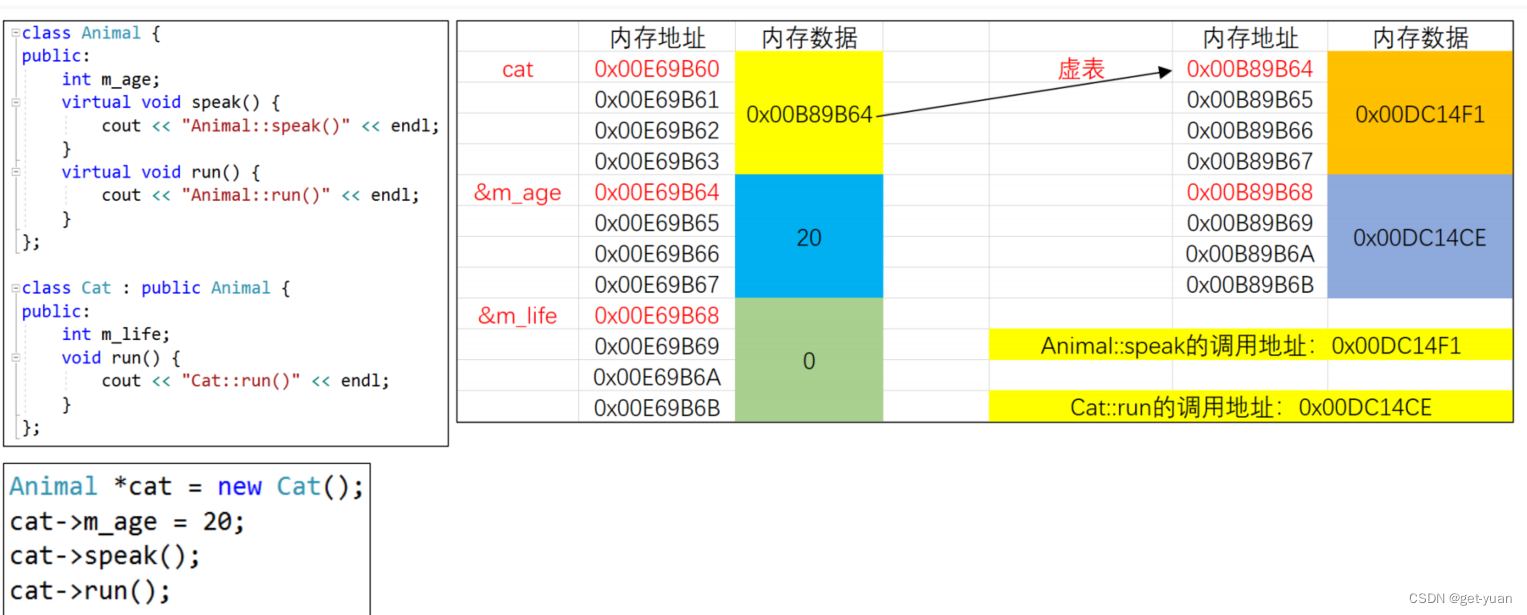父类指针、子类指针
- 父类指针可以指向子类对象,是安全的,开发中经常用到(继承方式必须是public)
- 子类指针指向父类对象是不安全的
#include<iostream>
using namespace std;
struct Person
{
int m_age;
};
struct Student:Person
{
int m_score;
};
int main() {
//父类指针指向子类对象
Person* p = new Student();
p->m_age = 10;
return 0;
}p指针只能操作m_age变量

多态
默认情况下,编译器只会根据指针类型调用对应的函数,不存在多态
多态是面向对象非常重要的一个特性:
- 同一操作作用于不同的对象,可以有不同的解释,产生不同的执行结果
- 在运行时,可以识别出真正的对象类型,调用对应子类中的函数
多态的要素:
- 子类重写父类的成员函数(override)
- 父类指针指向子类对象
- 利用父类指针调用重写的成员函数
虚函数
- C++中的多态通过虚函数(virtual function)来实现
- 虚函数:被virtual修饰的成员函数
- 只要在父类中声明为虚函数,子类中重写的函数也自动变成虚函数(也就是说子类中可以省略virtual关键字)
#include<iostream>
using namespace std;
//struct Person
//{
// int m_age;
//};
//struct Student:Person
//{
// int m_score;
//};
struct Animal
{
virtual void run() {
cout << "Animal::run()" << endl;
}
void speak() {
cout << "Animal::speak()" << endl;
}
};
struct Dog:Animal
{
void run() {
cout << "Dog::run()" << endl;
}
void speak() {
cout << "Dog::speak()" << endl;
}
};
struct Cat :Animal
{
void run() {
cout << "Cat::run()" << endl;
}
void speak() {
cout << "Cat::speak()" << endl;
}
};
struct Pig :Animal
{
void run() {
cout << "Pig::run()" << endl;
}
void speak() {
cout << "Pig::speak()" << endl;
}
};
void liu(Animal *p) {
p->speak();
p->run();
}
int main() {
//父类指针指向子类对象
/*Person* p = new Student();
p->m_age = 10;*/
liu(new Dog());
liu(new Cat());
liu(new Pig());
return 0;
}虚表
虚函数的实现原理是虚表,这个虚表里面存储着最终需要调用的虚函数地址,这个虚表也叫虚函数表
所有的Cat对象(不管在全局区还是、栈、堆)共用同一份虚表

#include<iostream>
using namespace std;
struct Animal
{
int m_age;
virtual void speak() {
cout << "Animal::speak()" << endl;
}
virtual void run() {
cout << "Animal::run()" << endl;
}
};
struct Cat:Animal
{
int m_life;
void speak() {
cout << "Cat::speak()" << endl;
}
void run() {
cout << "Cat::run()" << endl;
}
};
int main() {
cout << sizeof(Cat) << endl;
return 0;
}
调用父类的成员函数实现
struct Animal
{
virtual void speak() {
cout << "Animal::speak()" << endl;
}
};
struct Cat:Animal
{
void speak() {
Animal::speak();
cout << "Cat::speak()" << endl;
}
};